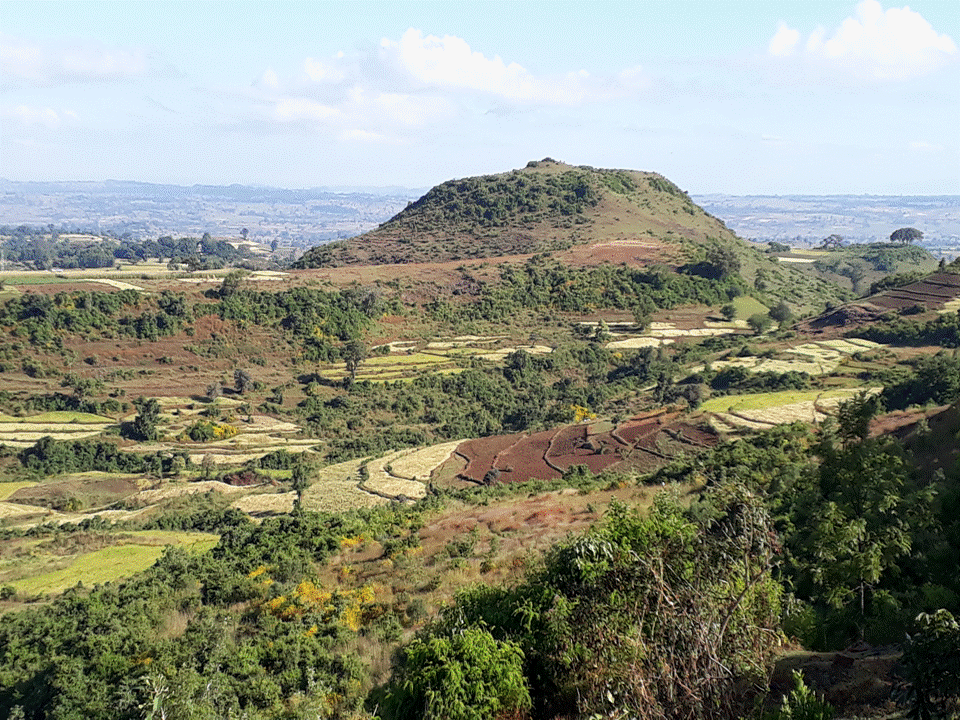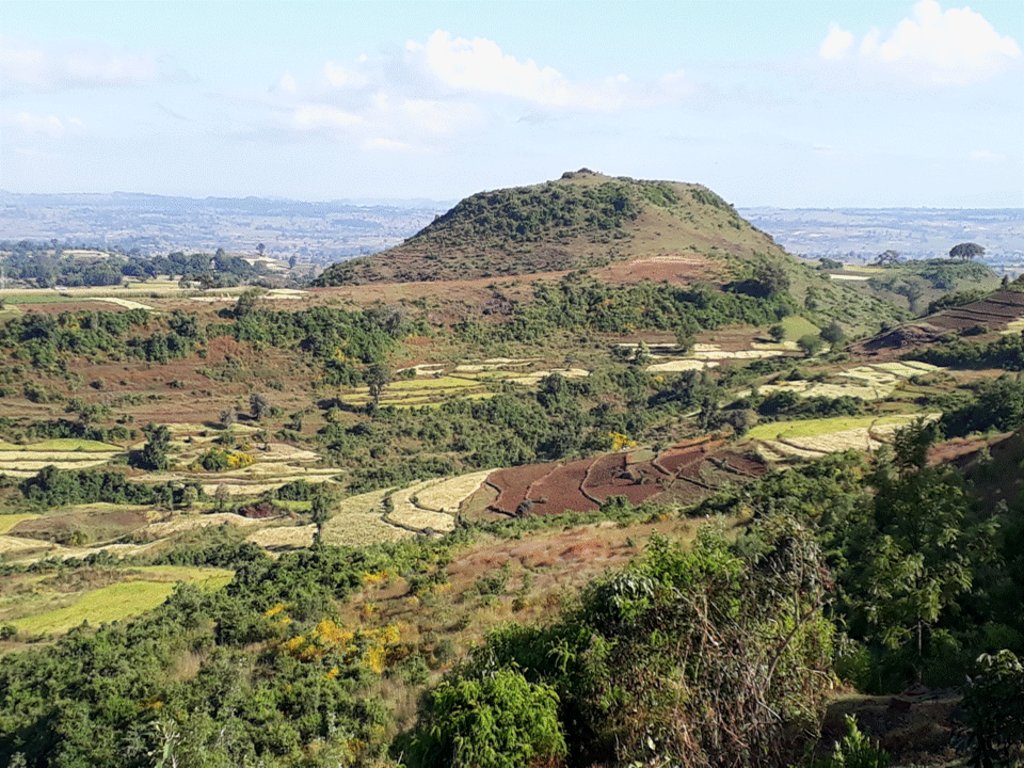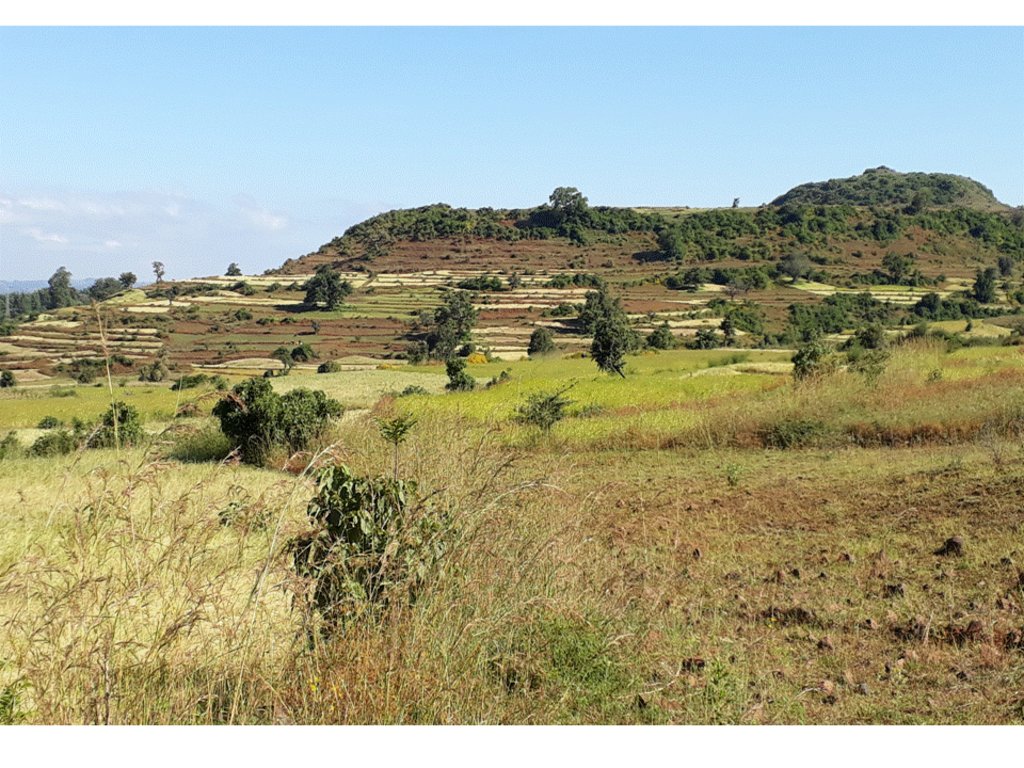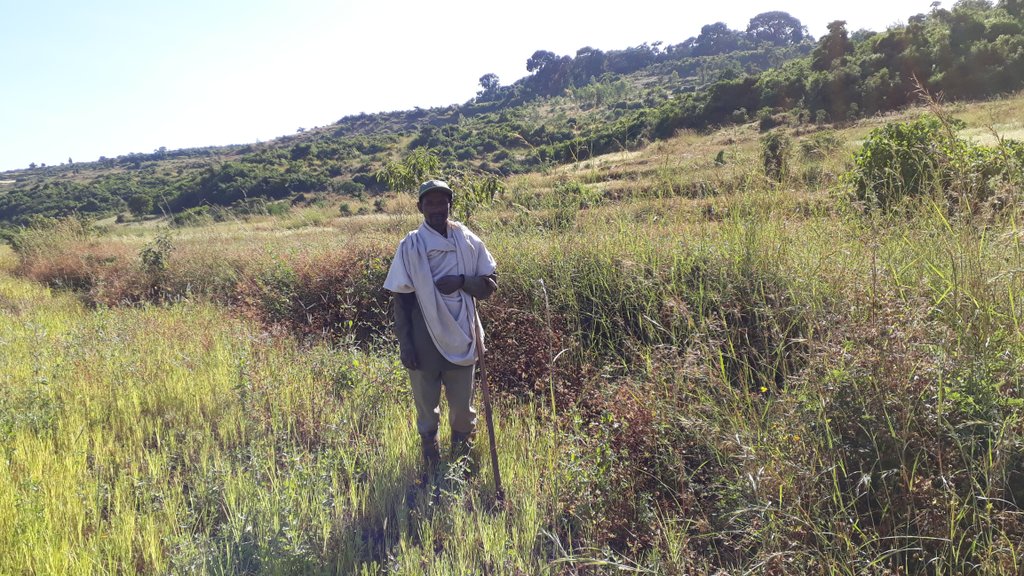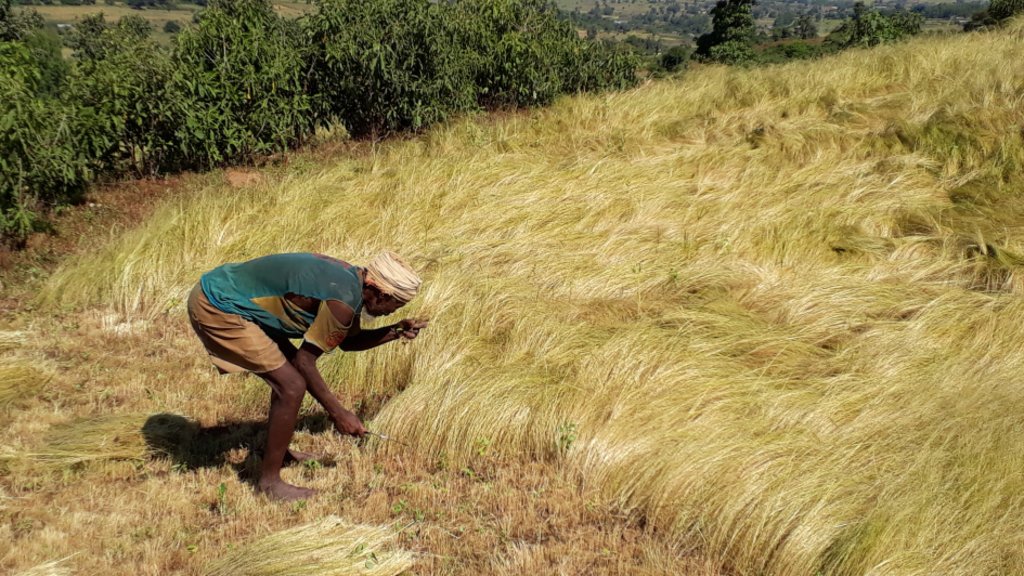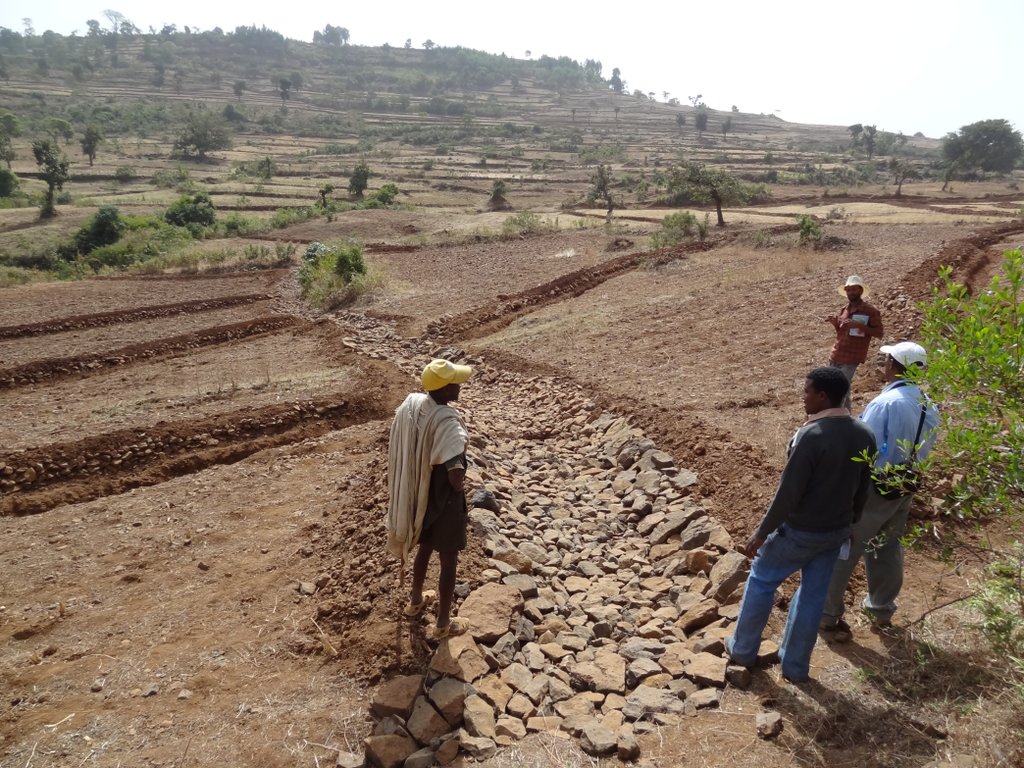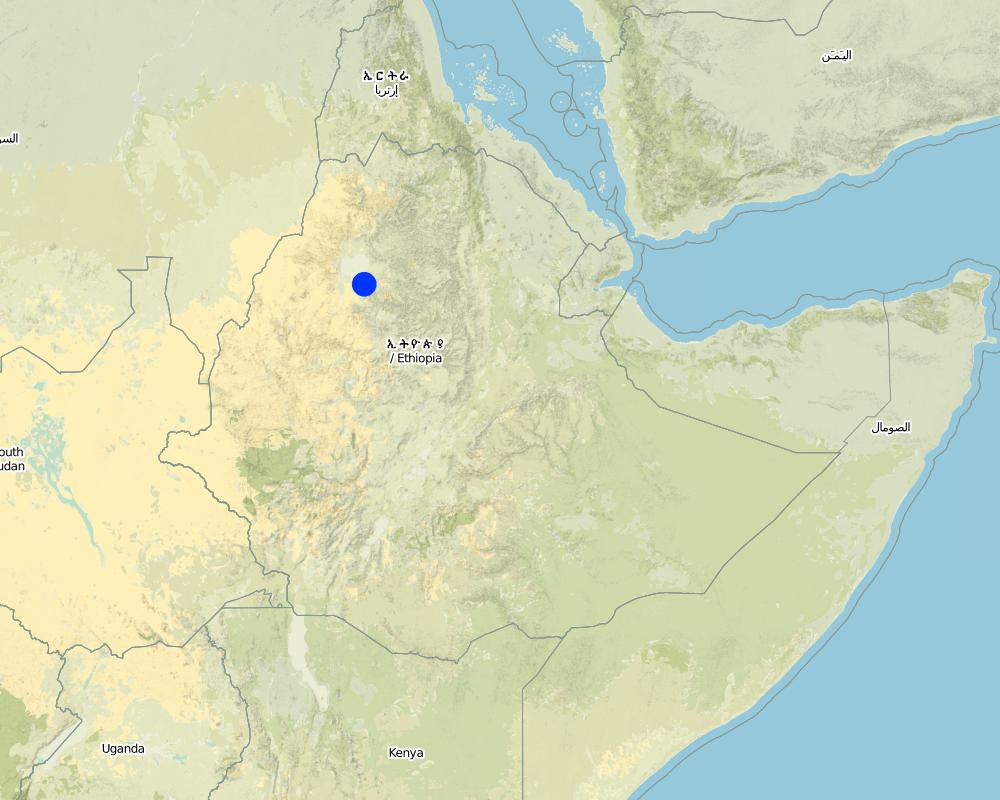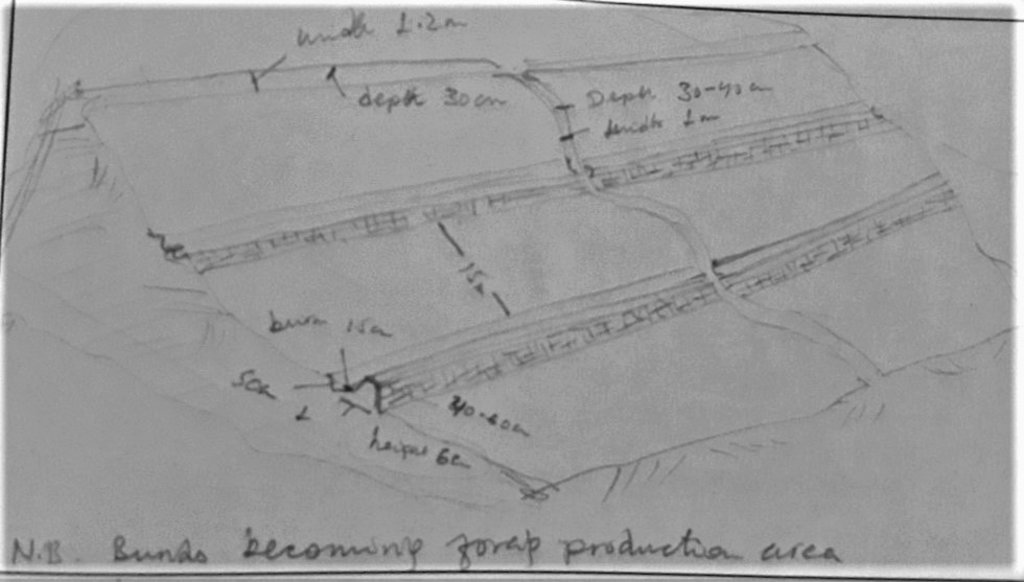Integrated Farm Land Conservation [Ethiopia]
- Creation:
- Update:
- Compiler: Yismaw Wuletaw
- Editor: –
- Reviewer: Tatenda Lemann
የተቀናጀ የእርሻ መሬት እንክብካቤ (yetekenaje yeirsha meriet inkibikabie)
technologies_4136 - Ethiopia
View sections
Expand all Collapse all1. General information
1.2 Contact details of resource persons and institutions involved in the assessment and documentation of the Technology
Key resource person(s)
land user:
Debeb Belete
Abagerima Kebele Association
Ethiopia
SLM specialist:
Name of project which facilitated the documentation/ evaluation of the Technology (if relevant)
Carbon Benefits Project (CBP)Name of the institution(s) which facilitated the documentation/ evaluation of the Technology (if relevant)
Bureau of Agriculture - Amhara Nation Regional State - Bahir Dar (amhboard) - EthiopiaName of the institution(s) which facilitated the documentation/ evaluation of the Technology (if relevant)
CDE Centre for Development and Environment (CDE Centre for Development and Environment) - SwitzerlandName of the institution(s) which facilitated the documentation/ evaluation of the Technology (if relevant)
Water and Land Resource Centre (WLRC) - Ethiopia1.3 Conditions regarding the use of data documented through WOCAT
The compiler and key resource person(s) accept the conditions regarding the use of data documented through WOCAT:
Ja
1.4 Declaration on sustainability of the described Technology
Is the Technology described here problematic with regard to land degradation, so that it cannot be declared a sustainable land management technology?
Nee
Comments:
The technology is directly related land degradation and hence it can be declared as sustainable land management technology.
2. Description of the SLM Technology
2.1 Short description of the Technology
Definition of the Technology:
Integrated Farm Land Conservation (IFLC) comprises of farm terrace (bund) construction, construction of drainage structures, bund stabilization and livestock exclosure,
2.2 Detailed description of the Technology
Description:
Integrated Farm Land Conservation (IFLC) is practiced within a watershed on individual farmland. Main characteristics of the technology are conserving soil and moisture and at the same time safe disposal of excess runoff.
Farm terrace construction is actually terrace development, starting with soil or stone bunding that enables the development of a terrace, i.e. bench formation due to soil erosion, sediment deposition and tillage movement through time (5-15 years). The bunds are levelled or graded, the walls having a bottom width of 0.8 - 1.0 m, and a top width of about 0.4 m, the bund height is up to 0.6 m. Bunds are constructed parallel to the slope or slightly graded, on slopes ranging from 8 - 20 % gradients, and at a the vertical interval of 1-2 m between two bunds. The bunds are stabilized with vegetative measures like grass and legume shrubs. The drainage structures consist of the ditch along bunds, cut-off drains above cultivated land and waterways through it, the depth of a cut-off drain being 0.3 - 0.4 m and the average width 1.5 m, the depth of the waterway being 0.3 - 0.5 m, and the width of the waterway being 1.5 - 2 m. For bund and terrace protection in the initial years, livestock is excluded and farmers exercise cut and carry. Livestock exclosure encourages land users to practice crop residue management.
The purpose of the technology, in general, is to conserve soil and water, minimizing slope gradients of the farmland, improve soil moisture, reduce compaction, enhance infiltration and thus improve the recharge of groundwater. Furthermore, livestock exclosure contributes to soil fertility enhancement following crop residue management. The technology initially maintains soil fertility and through time, it has its own contribution to the betterment / increment of crop yield. Nevertheless some farmers complain about the land being occupied by the bunds, although this is later on compensated, as forage can be produced on the riser slopes of the growing terraces.
2.3 Photos of the Technology
General remarks regarding photos:
The photos were all taken during field work on 24 October 2018, while several technologies were assessed by different compilers. In the Abagerima area a full watershed was developed in 2013 by the Water and Land Resource Centre, Addis Ababa University and Centre for Development and Environment (CDE), University of Bern, funded by Swiss Development Cooperation and its Ethiopian partners.
2.5 Country/ region/ locations where the Technology has been applied and which are covered by this assessment
Country:
Ethiopia
Region/ State/ Province:
Amhara Region, Ethiopia
Further specification of location:
Abagerima Watershed in the Highlands of Ethiopia
Specify the spread of the Technology:
- evenly spread over an area
If the Technology is evenly spread over an area, specify area covered (in km2):
3.0
If precise area is not known, indicate approximate area covered:
- 1-10 km2
Is/are the technology site(s) located in a permanently protected area?
Nee
Comments:
The site is not permanently protected. The site faced some damage due on and off free grazing instead of consistently exercising cut and carry practice. In some cases deliberate damage caused by few individuals by freely grazed the site.
Map
×2.6 Date of implementation
Indicate year of implementation:
2013
If precise year is not known, indicate approximate date:
- less than 10 years ago (recently)
2.7 Introduction of the Technology
Specify how the Technology was introduced:
- through projects/ external interventions
- Government led community free labor mobilization for the natural resource conservation measures
Comments (type of project, etc.):
Government-led community free labor mobilization for the natural resource conservation measures, supported by Water and Land Resource Centre, Addis Ababa University and Centre for Development and Environment, University of Bern.
3. Classification of the SLM Technology
3.1 Main purpose(s) of the Technology
- improve production
- reduce, prevent, restore land degradation
- protect a watershed/ downstream areas – in combination with other Technologies
- adapt to climate change/ extremes and its impacts
- create beneficial economic impact
3.2 Current land use type(s) where the Technology is applied
Land use mixed within the same land unit:
Ja
Specify mixed land use (crops/ grazing/ trees):
- Agro-silvopastoralism

Cropland
- Annual cropping
- Perennial (non-woody) cropping
- Tree and shrub cropping
Annual cropping - Specify crops:
- cereals - maize
- cereals - wheat (winter)
- legumes and pulses - other
- teff
Annual cropping system:
Continuous wheat/barley/oats/upland rice
Tree and shrub cropping - Specify crops:
- avocado
- coffee, shade grown
- mango, mangosteen, guava
- papaya
- Dodonaea angustifolia, Rhamnus Prinoides, Catha edulis
Number of growing seasons per year:
- 1
Is intercropping practiced?
Nee
Is crop rotation practiced?
Ja
If yes, specify:
maize followed by pulses followed by wheat followed by teff, and rarely, fallow.

Grazing land
Intensive grazing/ fodder production:
- Cut-and-carry/ zero grazing
Animal type:
- cattle - dairy
- cattle - non-dairy working
- goats
- mules and asses
- poultry
- sheep
- Bees
Is integrated crop-livestock management practiced?
Ja
If yes, specify:
cattle is mainly used for ploughing (oxen), sheep and goats for meat.
Products and services:
- meat
- milk
- transport/ draught
Species:
cattle - non-dairy working
Count:
2500
Species:
goats
Count:
830
Species:
sheep
Count:
2000
Species:
poultry
Count:
10200
Species:
mules and asses
Count:
1064

Forest/ woodlands
- (Semi-)natural forests/ woodlands
- Tree plantation, afforestation
(Semi-)natural forests/ woodlands: Specify management type:
- Dead wood/ prunings removal
- Non-wood forest use
Type of (semi-)natural forest:
- tropical moist deciduous forest natural vegetation
Tree plantation, afforestation: Specify origin and composition of species:
- Monoculture exotic variety
- Mixed varieties
Type of tree plantation, afforestation:
- tropical mountain systems plantation
Type of tree:
- Acacia species
- Eucalyptus globulus
- Cordia Africana, Olea african, Ficus vasta, Croton macrostachyus
Are the trees specified above deciduous or evergreen?
- mixed deciduous/ evergreen
Products and services:
- Timber
- Fuelwood
- Grazing/ browsing
Comments:
Livestock population data for the whole watershed
3.3 Has land use changed due to the implementation of the Technology?
Has land use changed due to the implementation of the Technology?
- Yes (Please fill out the questions below with regard to the land use before implementation of the Technology)
Land use mixed within the same land unit:
Ja
Specify mixed land use (crops/ grazing/ trees):
- Agro-silvopastoralism

Cropland
- Annual cropping
- Perennial (non-woody) cropping
- Tree and shrub cropping
Annual cropping - Specify crops:
- cereals - maize
- cereals - wheat (winter)
- legumes and pulses - other
- teff
Annual cropping system:
Continuous wheat/barley/oats/upland rice
Tree and shrub cropping - Specify crops:
- coffee, shade grown
- Dodonaea angustifolia, Rhamnus Prinoides, Catha edulis
Is intercropping practiced?
Nee
Is crop rotation practiced?
Ja
If yes, specify:
maize followed by pulses followed by wheat followed by teff, and rarely, fallow

Grazing land
Extensive grazing:
- Semi-nomadic pastoralism
- Ranching
Animal type:
- cattle - non-dairy working
- goats
- sheep
Is integrated crop-livestock management practiced?
Ja
If yes, specify:
livestock was allowed to graze all over the place before conservation, except on cultivated land during the growing season.
Products and services:
- meat
- milk
- transport/ draught

Forest/ woodlands
- (Semi-)natural forests/ woodlands
(Semi-)natural forests/ woodlands: Specify management type:
- Clear felling
- Dead wood/ prunings removal
Type of (semi-)natural forest:
- tropical mountain systems natural vegetation
Type of tree:
- Acacia species
- Eucalyptus globulus
Are the trees specified above deciduous or evergreen?
- mixed deciduous/ evergreen
Products and services:
- Timber
- Fuelwood
- Grazing/ browsing
Comments:
Land use change (of Abagerima watershed over the intervention periods (2010 and 2017):
Land use change Ha.
Cultivated land to bush/ shrub land4.1
Cultivated land to degraded grass land 3.9
Cultivated land to grass land 5.8
Cultivated land to Homestead 8.0
Cultivated land to plantation 4.9
Degraded grass land to bush/ shrub land 1.2
Grass land to bush/ shrub land 3.2
Grass land to cultivated land 6.1
Grass land to degraded grass land 4.0
Grass land to riverine vegetation1.2
Source: - Achievements and Impacts of Learning Watershed Approach: Technologies, Innovations and Evidence for Scaling up WLRC Research Report 3, Addis Ababa University, 2019, Addis Ababa
3.4 Water supply
Water supply for the land on which the Technology is applied:
- rainfed
Comments:
cropping is based mainly on rain-fed, farmers utilize groundwater for perennial crop production on a small scale in their homestead development areas
3.5 SLM group to which the Technology belongs
- area closure (stop use, support restoration)
- integrated crop-livestock management
- water diversion and drainage
3.6 SLM measures comprising the Technology

agronomic measures
- A2: Organic matter/ soil fertility
- A5: Seed management, improved varieties
- A6: Residue management
A6: Specify residue management:
A 6.4: retained

vegetative measures
- V2: Grasses and perennial herbaceous plants

structural measures
- S1: Terraces
- S2: Bunds, banks
- S3: Graded ditches, channels, waterways
- S4: Level ditches, pits

management measures
- M1: Change of land use type
- M2: Change of management/ intensity level
3.7 Main types of land degradation addressed by the Technology

soil erosion by water
- Wt: loss of topsoil/ surface erosion
- Wg: gully erosion/ gullying
- Wr: riverbank erosion
- Wo: offsite degradation effects

physical soil deterioration
- Pc: compaction
- Pi: soil sealing

biological degradation
- Bc: reduction of vegetation cover
- Bh: loss of habitats
- Bl: loss of soil life
- Bp: increase of pests/ diseases, loss of predators

water degradation
- Hs: change in quantity of surface water
- Hg: change in groundwater/aquifer level
- Hp: decline of surface water quality
- Hq: decline of groundwater quality
3.8 Prevention, reduction, or restoration of land degradation
Specify the goal of the Technology with regard to land degradation:
- prevent land degradation
- restore/ rehabilitate severely degraded land
4. Technical specifications, implementation activities, inputs, and costs
4.1 Technical drawing of the Technology
Technical specifications (related to technical drawing):
The height of the bund is less than 0.6 m, the width of the bund is less than 1.6 m, the average slope is 8 - 15 %, the veritcal interval between two bunds is 1- 2 m, and the average spacing between structures is about 15 m
Author:
Yismaw Wuletaw
Date:
24/10/2018
4.2 General information regarding the calculation of inputs and costs
Specify how costs and inputs were calculated:
- per Technology area
Indicate size and area unit:
300 ha
Specify currency used for cost calculations:
- USD
If relevant, indicate exchange rate from USD to local currency (e.g. 1 USD = 79.9 Brazilian Real): 1 USD =:
1.0
Indicate average wage cost of hired labour per day:
3 USD
4.3 Establishment activities
| Activity | Timing (season) | |
|---|---|---|
| 1. | Cutoff drain | After crop harvesting |
| 2. | Waterway | After crop harvesting |
| 3. | Stone-faced soil bund | After crop harvesting |
| 4. | Bund stabilization | At the onset of the rainy season |
4.4 Costs and inputs needed for establishment
| Specify input | Unit | Quantity | Costs per Unit | Total costs per input | % of costs borne by land users | |
|---|---|---|---|---|---|---|
| Labour | cutoff-off drain | Person day | 2600.0 | 3.0 | 7800.0 | 1.0 |
| Labour | Waterway | Person day | 3500.0 | 3.0 | 10500.0 | 1.0 |
| Labour | Stone-faced soil bund | Person day | 14100.0 | 3.0 | 42300.0 | 1.0 |
| Labour | Bund stabilization | Person day | 1500.0 | 3.0 | 4500.0 | 1.0 |
| Other | Hand tools (shovel, pick-ax) | No | 1080.0 | 2.89 | 3121.2 | 0.0 |
| Other | Water level | No | 24.0 | 2.17 | 52.08 | 0.0 |
| Total costs for establishment of the Technology | 68273.28 | |||||
| Total costs for establishment of the Technology in USD | 68273.28 | |||||
If land user bore less than 100% of costs, indicate who covered the remaining costs:
Government-led community free labor mobilization for the natural resource conservation measures, supported by Water and Land Resource Centre, Addis Ababa University and Centre for Development and Environment, University of Bern.
Comments:
The community contributed free labor contribution. The government and Water and Land Resource Center provided technical(capacity building and monitoring) and input support.
According to the 2019 Project unpublished report, the total person days (pds) for Abagerima Community Watershed is 181,920 and for Integrated Farm land Conservation approximately 43,400 person days (Source: Gombat and Laguna Kebele level Office of Agriculture). By virtue, the community contributed their labour almost for half working day (four hours) the total person days have been divided by 2 and multiplied by 3 USD (which is the approximate daily rate).
Regarding the tool cost, the cost was covered by the government and the project (WLRC).
4.5 Maintenance/ recurrent activities
| Activity | Timing/ frequency | |
|---|---|---|
| 1. | Cutoff drain | After crop harvesting |
| 2. | Waterway | After crop harvesting |
| 3. | Stone-faced soil bund | After crop harvesting |
| 4. | Bund stabilization | At the onset of the rain |
4.6 Costs and inputs needed for maintenance/ recurrent activities (per year)
| Specify input | Unit | Quantity | Costs per Unit | Total costs per input | % of costs borne by land users | |
|---|---|---|---|---|---|---|
| Labour | Stone faced soil bund | person day | 10000.0 | 3.0 | 30000.0 | 1.0 |
| Labour | Bund stabilization | person day | 200.0 | 3.0 | 600.0 | 10.0 |
| Total costs for maintenance of the Technology | 30600.0 | |||||
| Total costs for maintenance of the Technology in USD | 30600.0 | |||||
If land user bore less than 100% of costs, indicate who covered the remaining costs:
The community contributed free labor contribution. The WLRC provided capacity development and input support.
4.7 Most important factors affecting the costs
Describe the most determinate factors affecting the costs:
The season, as especially during sowing, weeding and harvesting times the labour costs are scarce and hence, high.
5. Natural and human environment
5.1 Climate
Annual rainfall
- < 250 mm
- 251-500 mm
- 501-750 mm
- 751-1,000 mm
- 1,001-1,500 mm
- 1,501-2,000 mm
- 2,001-3,000 mm
- 3,001-4,000 mm
- > 4,000 mm
Agro-climatic zone
- sub-humid
5.2 Topography
Slopes on average:
- flat (0-2%)
- gentle (3-5%)
- moderate (6-10%)
- rolling (11-15%)
- hilly (16-30%)
- steep (31-60%)
- very steep (>60%)
Landforms:
- plateau/plains
- ridges
- mountain slopes
- hill slopes
- footslopes
- valley floors
Altitudinal zone:
- 0-100 m a.s.l.
- 101-500 m a.s.l.
- 501-1,000 m a.s.l.
- 1,001-1,500 m a.s.l.
- 1,501-2,000 m a.s.l.
- 2,001-2,500 m a.s.l.
- 2,501-3,000 m a.s.l.
- 3,001-4,000 m a.s.l.
- > 4,000 m a.s.l.
Indicate if the Technology is specifically applied in:
- not relevant
5.3 Soils
Soil depth on average:
- very shallow (0-20 cm)
- shallow (21-50 cm)
- moderately deep (51-80 cm)
- deep (81-120 cm)
- very deep (> 120 cm)
Soil texture (topsoil):
- medium (loamy, silty)
Soil texture (> 20 cm below surface):
- medium (loamy, silty)
- fine/ heavy (clay)
Topsoil organic matter:
- medium (1-3%)
- low (<1%)
5.4 Water availability and quality
Ground water table:
< 5 m
Availability of surface water:
medium
Water quality (untreated):
poor drinking water (treatment required)
Water quality refers to:
surface water
Is water salinity a problem?
Nee
Is flooding of the area occurring?
Nee
5.5 Biodiversity
Species diversity:
- low
Habitat diversity:
- low
5.6 Characteristics of land users applying the Technology
Sedentary or nomadic:
- Sedentary
Market orientation of production system:
- mixed (subsistence/ commercial)
Off-farm income:
- less than 10% of all income
Relative level of wealth:
- poor
- average
Individuals or groups:
- individual/ household
Level of mechanization:
- manual work
- animal traction
Gender:
- women
- men
Age of land users:
- youth
- middle-aged
5.7 Average area of land used by land users applying the Technology
- < 0.5 ha
- 0.5-1 ha
- 1-2 ha
- 2-5 ha
- 5-15 ha
- 15-50 ha
- 50-100 ha
- 100-500 ha
- 500-1,000 ha
- 1,000-10,000 ha
- > 10,000 ha
Is this considered small-, medium- or large-scale (referring to local context)?
- small-scale
5.8 Land ownership, land use rights, and water use rights
Land ownership:
- state
- individual, titled
Land use rights:
- communal (organized)
- individual
Water use rights:
- open access (unorganized)
- individual
Are land use rights based on a traditional legal system?
Nee
Comments:
In case of drinking water, there is some organization to manage the resource
5.9 Access to services and infrastructure
health:
- poor
- moderate
- good
education:
- poor
- moderate
- good
technical assistance:
- poor
- moderate
- good
employment (e.g. off-farm):
- poor
- moderate
- good
markets:
- poor
- moderate
- good
energy:
- poor
- moderate
- good
roads and transport:
- poor
- moderate
- good
drinking water and sanitation:
- poor
- moderate
- good
financial services:
- poor
- moderate
- good
6. Impacts and concluding statements
6.1 On-site impacts the Technology has shown
Socio-economic impacts
Production
crop production
Comments/ specify:
It is because of integrated farmland conservation measures and improved use of agricultural input
crop quality
fodder production
fodder quality
Comments/ specify:
Weed also grows together with forage grass and reduces the quality of grass.
animal production
wood production
forest/ woodland quality
non-wood forest production
risk of production failure
product diversity
production area
land management
Water availability and quality
drinking water availability
drinking water quality
water availability for livestock
water quality for livestock
irrigation water availability
irrigation water quality
demand for irrigation water
Income and costs
expenses on agricultural inputs
farm income
diversity of income sources
economic disparities
workload
Socio-cultural impacts
food security/ self-sufficiency
health situation
land use/ water rights
community institutions
SLM/ land degradation knowledge
conflict mitigation
situation of socially and economically disadvantaged groups
Ecological impacts
Water cycle/ runoff
water quantity
water quality
harvesting/ collection of water
surface runoff
excess water drainage
groundwater table/ aquifer
evaporation
Comments/ specify:
This includes evapotranspiration
Soil
soil moisture
soil cover
soil loss
soil accumulation
soil crusting/ sealing
soil compaction
nutrient cycling/ recharge
Comments/ specify:
Crop residue management following livestock exclosure from the farmland.
salinity
soil organic matter/ below ground C
acidity
Biodiversity: vegetation, animals
Vegetation cover
biomass/ above ground C
plant diversity
invasive alien species
Comments/ specify:
Not alien species, but the common weed species getting spread.
animal diversity
beneficial species
Comments/ specify:
But the bee colony is getting decreased due to the use of pesticide and insecticide.
habitat diversity
pest/ disease control
Climate and disaster risk reduction
flood impacts
landslides/ debris flows
drought impacts
impacts of cyclones, rain storms
emission of carbon and greenhouse gases
Comments/ specify:
Due to minimizing the number of livestock from time to time. It is due to the fact that farmers are unable to manage under better/ intensive management following controlled grazing.
fire risk
wind velocity
micro-climate
6.2 Off-site impacts the Technology has shown
water availability
reliable and stable stream flows in dry season
Comments/ specify:
Seasonal streams apparently have runoff longer into the dry season than before soil and water conservation, according to land users' observations.
downstream flooding
downstream siltation
groundwater/ river pollution
buffering/ filtering capacity
wind transported sediments
damage on neighbours' fields
6.3 Exposure and sensitivity of the Technology to gradual climate change and climate-related extremes/ disasters (as perceived by land users)
Gradual climate change
Gradual climate change
| Season | increase or decrease | How does the Technology cope with it? | |
|---|---|---|---|
| annual temperature | increase | well | |
| seasonal temperature | dry season | increase | well |
| annual rainfall | well |
Climate-related extremes (disasters)
Meteorological disasters
| How does the Technology cope with it? | |
|---|---|
| tropical storm | well |
| local rainstorm | well |
| local thunderstorm | moderately |
| local hailstorm | moderately |
6.4 Cost-benefit analysis
How do the benefits compare with the establishment costs (from land users’ perspective)?
Short-term returns:
negative
Long-term returns:
positive
How do the benefits compare with the maintenance/ recurrent costs (from land users' perspective)?
Short-term returns:
slightly positive
Long-term returns:
positive
Comments:
The farmland owner considers "with" and "without" scenario and the comparative labour cost.
6.5 Adoption of the Technology
- > 50%
Of all those who have adopted the Technology, how many did so spontaneously, i.e. without receiving any material incentives/ payments?
- 91-100%
6.6 Adaptation
Has the Technology been modified recently to adapt to changing conditions?
Nee
6.7 Strengths/ advantages/ opportunities of the Technology
| Strengths/ advantages/ opportunities in the land user’s view |
|---|
| 1. Conserving the soil and water and hence reduce flood hazard, 2. Avoiding traditional ditches and minimizing conflict due flood, 3. Minimizing/ lowering the slope of the farmland, 4. Improving the surface and groundwater potential, 5. Contributing to the betterment of yield, |
| Strengths/ advantages/ opportunities in the compiler’s or other key resource person’s view |
|---|
| 1. Conserving the soil and water and hence reduce flood hazard, 2. Avoiding traditional ditches and minimizing conflict due flood, 3. Minimizing/ lowering the slope of the farmland, 4. Improving the surface and groundwater potential, 5. Maintain soil fertility and through time improves the fertility status, 6. Contributing to the betterment of yield. |
6.8 Weaknesses/ disadvantages/ risks of the Technology and ways of overcoming them
| Weaknesses/ disadvantages/ risks in the land user’s view | How can they be overcome? |
|---|---|
| Expansion of rodents, | Construction of ditches to protect rodents around the farm. |
| Land occupied by the structures. | Producing forage on the structures including bunds and drainage structures. |
| Weaknesses/ disadvantages/ risks in the compiler’s or other key resource person’s view | How can they be overcome? |
|---|---|
| Unable to utilize more the area occupied by the structure. | Considering agroclimatic situation of the area, there is an opportunity to produce high-value crops. So, better to consider forage, selected fruit or other trees that will produce short, medium and long-term benefits. |
| Limitation on integration of biological measures (agronomic measures), like green manuring, inter-cropping to improve soil fertility and hence minimize flood/erosion, and to improve productivity, | Providing inputs aiming at demonstrating how to practice green manuring (like Lupine, Sesbania sesban) and inter-cropping (like pigeon pea, which offers additional production besides to soil fertility). |
| Limitation, partially, on maintaining the interval between two successive bunds. | Establishing grass, bushes, fruit hedgerows in between two successive bunds. |
| Limitation on the number of tillage operations. | Minimizing the number of tillage for annual crop production not to further disturb soil aggregates and enhance sealing and run off. Better to consider conservation agriculture (CA) if capacity building and input provision is put in place for demonstration and dissemination. |
| Limitation on institutional capacity building (from the community watershed committee up to the regional and federal levels) regarding the concept of Integrated farm land conservation (the view is focused more on physical structures and to some extent on bund stabilization). | Building the capacity of the respective heads/ leaders/ community representatives on the role of integrating bio-physical and soil fertility enhancement measures so as to maximize the benefits of soil and moisture conservation, improve infiltration/ recharging, minimize soil erosion, enhance soil fertility and hence crop productivity in a sustained manner. Thus the contribution for carbon sequestration is also enhanced. |
| The declining trend in traditional crop rotation leads to soil fertility depletion and aggravates crop pests. | Improving soil fertility, use of input (selective crop varieties and organic and inorganic fertilizers), and improving the traditional crop rotation so as to minimize soil fertility depletion. |
7. References and links
7.1 Methods/ sources of information
- field visits, field surveys
Two
- interviews with land users
Mr. Belete Debeb
- interviews with SLM specialists/ experts
Mr. Melese Bililgin
When were the data compiled (in the field)?
24/10/2018
Comments:
Transect walk was undertaken through the watershed. An interview was done with the land user.
7.2 References to available publications
Title, author, year, ISBN:
Integrated Farm Land, Conservation, Yismaw Wuletaw, 2018
Available from where? Costs?
Can be obtained from author
7.3 Links to relevant online information
Title/ description:
none
URL:
-
7.4 General comments
The questionnaire is easily understood and can be filled provided that the information can be collected in the field or with informants.
General remark: The comments are forwarded, as observed at field, because when we talk about Integrated Farm Land Conservation (IFLC), it should be integrated as much as possible/ inclusive for better results, as the ultimate goals of IFLC are:
oEnvironmental benefits - Conserving soil and moisture, carbon sequestration, improving the local climate;
oEconomic benefits - improving crop productivity, generating forage as a result of structural stabilization, and if it is implemented in an organized manner, it can also generate further economic benefits from gesho, fruit and selected trees like Grevillea robusta and Acacia dicurrens planted on structures;
oSocial benefits – contributing to social prestige as a result of producing reasonable production (if the concept of “optimizing the productivity per unit area, water and time” is respected, the livelihood of the rural community is also improved simply due to maintaining healthy soil and use of input for structural stabilization – i.e making the structures productive. In advanced terms, if IFLC is implemented in a well organized manner, the production through protection concept will be maintained. Thus, IFLC will contribute to the stability of the community within their surroundings/ watersheds and enable the transferring healthy soil/ land for the next generation.
Links and modules
Expand all Collapse allLinks
No links
Modules
No modules


